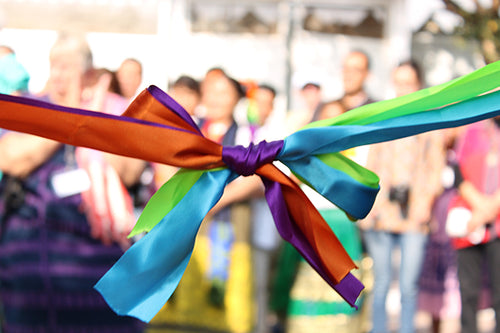
Sociedad Cooperativa Textil Artesanal La Piedad, Cotija de la Paz, Michoacán
La Sociedad Cooperativa Textil Artesanal de La Piedad was founded in 1963 by a group of 30 rebozo artisans who wanted to set up their own workshop and not have to work for others who owned looms and the raw materials, paying them by the piece.
Today 24 associates are still active and almost all are in their 70s. Their President, José Reyes Pérez is 76. Only one son of an artisan, now 30 years old, is continuing in this line of work. José says that young people are looking to make more money with much less effort.
Each artisan prepares his own ikat or jaspe warp, doing the tying, dyeing and weaving of 44-56 rebozos per set-up. For generations foot-looms have been used in this community and the use of artisela (rayon-silk) was introduced in the 20th Century. Fringes are knotted and/or plaited by women in the outlying communities, a practice common in all rebozo weaving centers.
The Coop also produces solid-color rebozos with knotted fringes Amarrado is the process of tying off parts of the warp (the vertical threads eventually affixed to the loom — the first 5 photos at the bottom of the page). The worker will first lay out the warp on a table and randomly pick up several threads. He or she will carefully wrap a short piece of thread around and covering the selected warp threads and carefully cuts the end of the thread with a knife. This process continues until the desired portions of the warp have all been worked on. The weavers say this is done nudo a nudo (knot by knot).
Then dye is passed over the warp. The same sharp knife then carefully cuts off the short threads in a process called desatar revealing portions of white on the warp where the dye did not adhere. Then when the weaver begins weaving, these random white portions of the warp blend with the weft (the horizontal thread that is passed back and forth through the warp) threads to form a unique pattern that will be different on every rebozo.
DEBAÑADO: System used to dye the artisela (silk) so that its color is consistent throughout.
URDIDO: Preparing the warp.
AMARRADO: Process described above that gives the garment its marbled effect
TEÑIDO: Process of passing the dye over the warp to give it color.
DESATADO: Taking the knots (small threads) that had been wrapped around portions of the warp's threads (see description above).
EMPAREJADO: Warping the loom to ensure that the amarrado design will line up correctly.
DESPEGADO: It consists of separating the yarns during weaving.
TRAMADO: The weaver weaving the garment.
ENPUNTADO: Process of weaving figures into the rebozo.
Justo Sierra #288
Col. Acapalquito
Cotija de la Paz, Michoacán (La Piedad)
394 534 4616
rsanchez@altius.org

